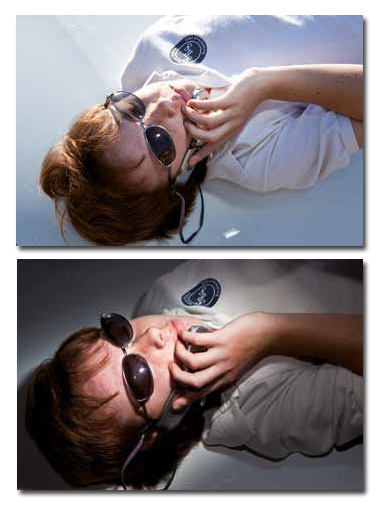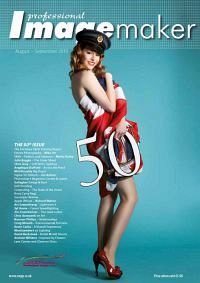articles/Lighting/shadowing-page5
Shadowing - and Other Revolutionary Ideas For Speedliting - part 5 of 1 2 3 4 5
Published 01/08/2010

Consider the differences in design between a Speedlite and other types of flash. Specifically, consider the difference in the path of the light as it leaves the unit. In a Speedlite, the flashtube is encased between a reflector and several lenses, so the light always flies forward. With other types of flash, the tube is cylindrical, so the light flies in virtually every direction. This is why it is much easier to make a monolight look hard than it is to make a Speedlite look soft.
When light is said to be soft, it means that the shadows lack a defined edge and their contrast is very low. Soft light is created when light comes at the subject from many angles. Now do not think that a soft light does not create shadows. Actually, the rays coming from the left side throw shadows to the right and vice versa. The difference is that the light coming from the other side fills the shadows such that they are minimised or disappear completely.
For a light source to send rays at a subject from multiple angles, the source must be significantly larger than the subject. You know this already. On a clear day, the sun fills a relatively small portion of the sky and your shadow is hard. Then, after a layer of clouds drifts in, your shadow becomes very soft because the clouds occupy a much larger portion of the sky. The clouds effectively becomes the light source and send the light at you from multiple angles.
So, how to make a Speedlite appear much larger? If you are a novice, then I suggest that you acquire a shoot-through (white satin) umbrella along with the requisite adapter and the ingenious Manfrotto 5001B light stand. For the price, an umbrella is the most economical way to start modifying your Speedlite. Know that the umbrella's curved surface throws light everywhere. For a bit of control,
I prefer convertible umbrellas and use the removable cover to flag a portion of the light so that it does not hit the background or to create a vignette as the soft light cascades down my subject.
When it's time for more control, you will want to step up to a soft box. The advantage of a soft box is that the flat front is not as generous with the distribution of light-meaning that you can limit where it flies and still create soft shadows. For Speedliting, I'm quite fond of the 2" and 30" Ezyboxes made by Lastolite. Their recessed front enables me to control where the edge of the light falls in relation to the subject.
Please Note:
There is more than one page for this Article.
You are currently on page 5
- Shadowing - and Other Revolutionary Ideas For Speedliting page 1
- Shadowing - and Other Revolutionary Ideas For Speedliting page 2
- Shadowing - and Other Revolutionary Ideas For Speedliting page 3
- Shadowing - and Other Revolutionary Ideas For Speedliting page 4
- Shadowing - and Other Revolutionary Ideas For Speedliting page 5
1st Published 01/08/2010
last update 09/12/2022 14:58:52
More Lighting Articles
There are 17 days to get ready for The Society of Photographers Convention and Trade Show at The Novotel London West, Hammersmith ...
which starts on Wednesday 14th January 2026





